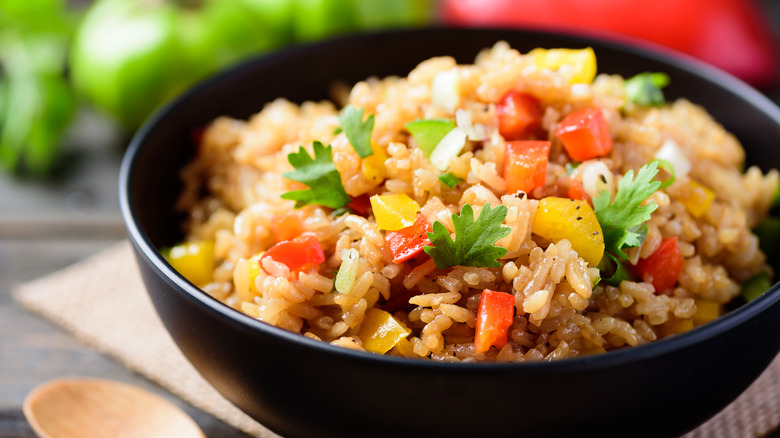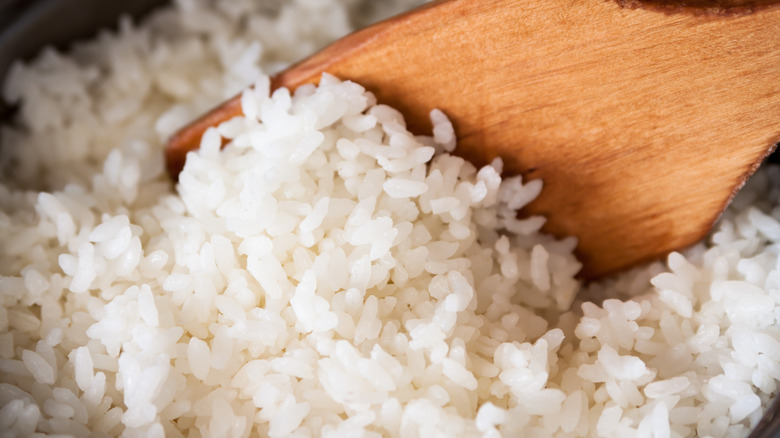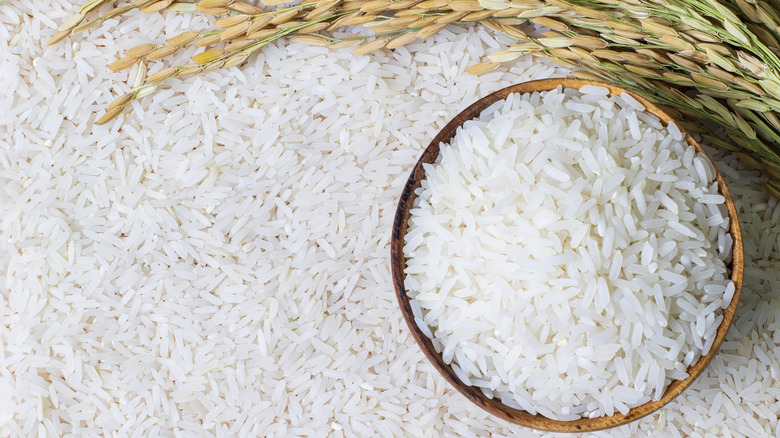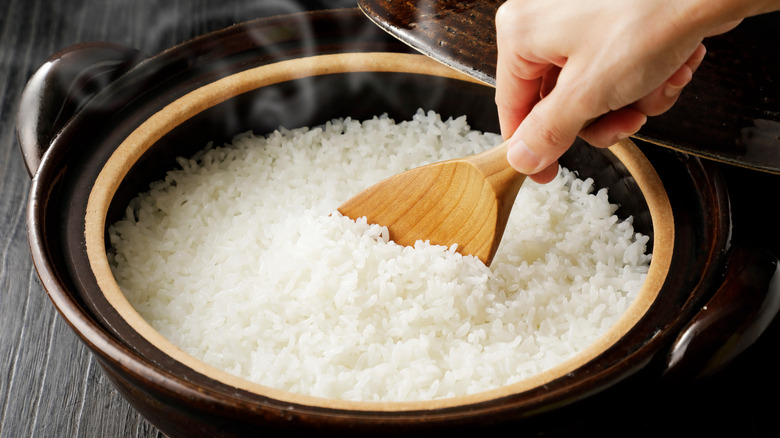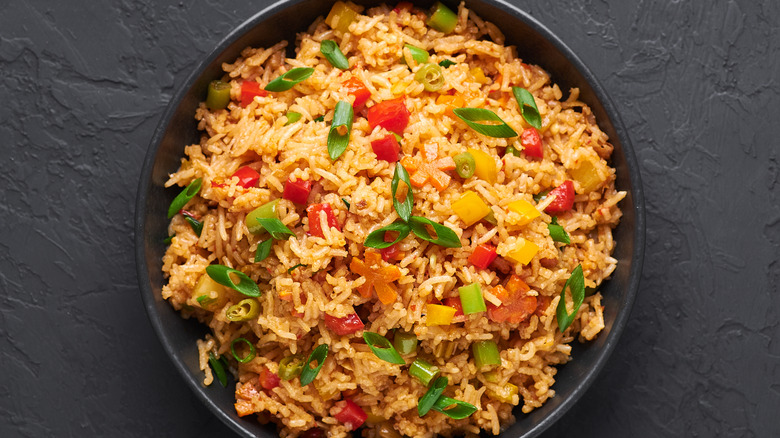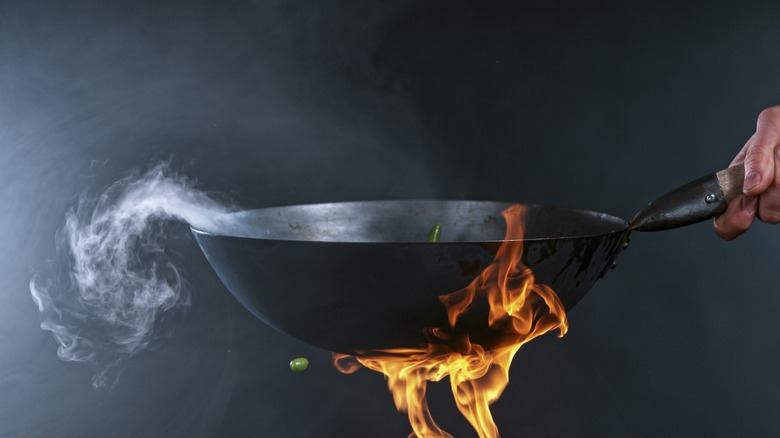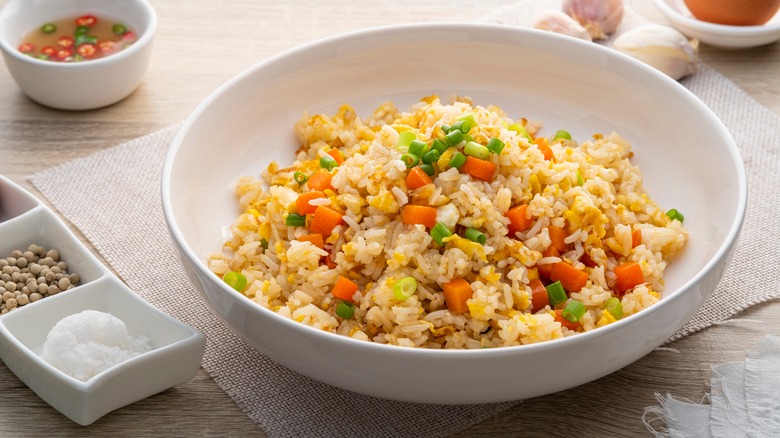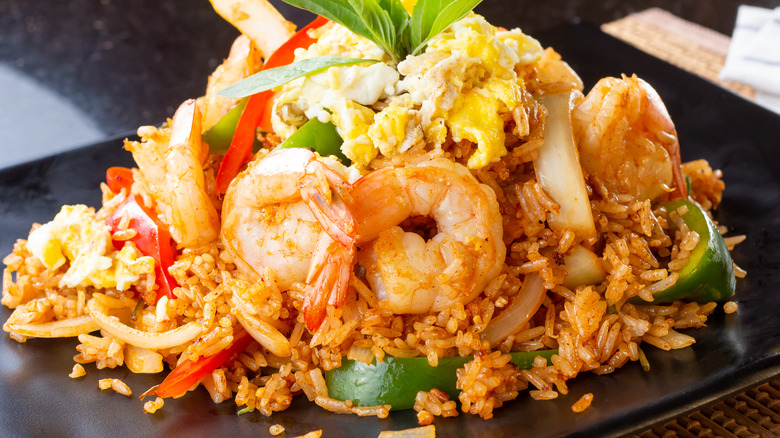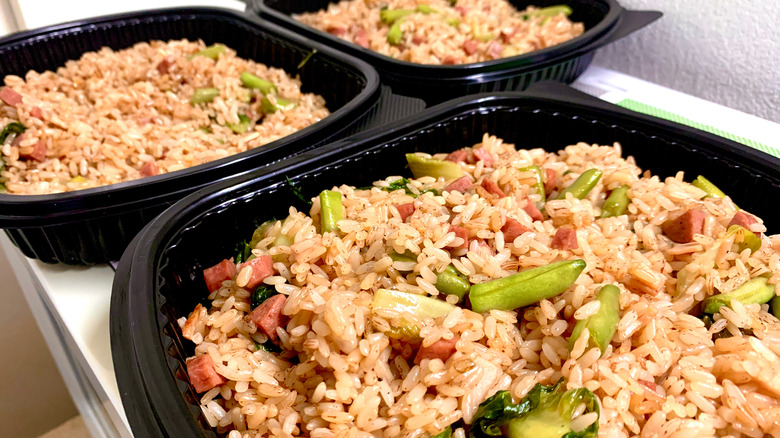12 Mistakes That Are Ruining Your Fried Rice
We're of the firm opinion that foods don't get much better than fried rice. Originating from China, this simple dish was first used as a way to repurpose leftover rice into a meal of its own and has since become a recipe that's beloved around the world. With the rice base serving as a vehicle for all manner of vegetables, proteins, and flavor combos, fried rice is infinitely customizable — and for many people is a must-have addition to their Chinese restaurant order.
But, as with all things that look easy, making good fried rice is actually pretty difficult. Too many of us have embarked on making a bowl of fried rice and ended up with a mushy mess, an overly salty meal, or with some part of it drastically undercooked. Before you put away your wok for good, however, there's help at hand. We're here to show you all of the mistakes you're making with your fried rice, and how to avoid them, so you can get a perfect meal every time.
Using badly-cooked rice
What's the most important part of fried rice? No prizes for knowing the answer here, folks: It's (drumroll please) the rice! As the main component of the dish, you'll want to make sure that the rice you're starting with is as good as can be, and that all starts with how you cook it. Adding too much or too little water, or cooking for too long, can leave you with rice that's either mushy, crunchy, soggy, or burnt, all of which are poor places to start for fried rice (via the Foods Guy).
So, make sure that you're cooking your rice correctly. While using a rice cooker is an easy way to do it, it's simple enough to cook on the stove if you use the right method. The rice brand you buy should have specific instructions, but as a general rule of thumb, rinse your rice, strain it, and then place it into a pan that has a tight lid. Then, add cold water, with a general ratio of between 1 to 2 cups of water for every cup of rice (if your lid is especially airtight, you'll need less liquid — for a loose lid, you'll need more). Let it simmer for between 12-15 minutes, longer if you're making brown rice, without stirring it. Then, take it off the heat, leave it to rest for a few minutes more, and then fluff it up with a fork. Perfect rice, every time.
You're picking the wrong rice grain
There are many distinct types of rice, and as you might expect, using different varieties will leave you with a different eventual fried rice. But there are certain rice types you should lean toward for fried rice, and some you should avoid. It's best to opt for medium-grain white rice varieties, like Thai jasmine rice. Thai jasmine rice is great at keeping its grains distinct, but it still has a great level of chewiness and moisture, meaning that your fried rice doesn't get too dry.
Although it may seem logical that other white rice varieties are as good as Thai jasmine or other medium-grain rice, unfortunately, this isn't the case. Short-grain rice, such as sushi rice, tends to be way too sticky, and won't separate properly when you fry it. Glutinous rice may be even worse than sushi rice, thanks to its tendency to coagulate together. On the other end of the spectrum, long-grain rice can be a little too thin and lacking in moisture.
So what about brown rice? Well, the good news is that you can indeed use it to make fried rice, and doing so could give you a boost of fiber, protein, and other nutrients. Just bear in mind that as brown rice has a slightly nuttier, heartier flavor than its white counterpart, this may affect the flavor of your final product.
Don't make it with rice straight out of the pot
So, you have a hankering for fried rice, but your local Chinese restaurant is closed, and you don't have any leftover rice in the fridge. But you do have a bag of rice in the pantry, and a pot ... Surely, just cooking some rice up and throwing it into your wok will solve this problem, right?
Well, not quite. Unfortunately, cooking fried rice with freshly-cooked rice is a surefire way to end up with a mushy mess. Freshly-cooked rice has a particularly high moisture content, and when this comes into contact with your hot pan, things steam up quickly and the soft rice can break down.
That's why it's far better to use leftover rice to make a fried rice dish. When you leave rice for a while after cooking it, it dries out slightly, and this partially-dry texture is perfect for frying. When it hits the hot pan, the rice rehydrates, with the grains frying up while remaining robust. The good news, though, is that you don't have to make rice days in advance to do this. If you're pressed for time, take your newly-cooked pot of rice, and spread an even layer of it on a baking sheet. Then, leave it for roughly half an hour. This will let all the steam evaporate, with the rice drying out a bit, making it easier to fry.
You're using rice that's gone bad
Using day-old rice for fried rice is a trick that aficionados of the dish know well. But use rice that's a little too old, and you could start to face some problems. Rice has a propensity to become dangerous for consumption when it's past its prime, with a bacteria called Bacillus cereus prone to growing on it, explains Medical News Today. This bacteria can cause pretty nasty food poisoning, with vomiting, diarrhea, fever, and other potential symptoms as a result. Eating especially old rice may have even more serious health consequences.
Luckily, reheating rice that's not too old, and using it in fried rice, isn't normally dangerous — you just have to make sure you're storing it correctly, and look out for some warning signs. Ensure that you're keeping your rice in a sealed container, only putting it in the refrigerator once it's fully cooled. Then, when it comes to using it, look out for any mold growths or discoloration on the rice, and check for weird smells or a slimy texture. You should also check to see if it's notably hard or dry, as this could indicate the rice has become unusable. Make sure, too, that you're frying it at a high temperature, and eat it as soon as your meal is ready.
The heat isn't high enough
If you've ever ordered fried rice in a Chinese restaurant, you'll be well aware of the fact that the first mouthful can leave you reaching rapidly for a glass of water to cool it down. But that high heat is vital to the cooking process of fried rice, and cooking at too low a temperature can leave you with a disappointing meal. So, make sure you're cooking at as high a heat as possible. When you crank up the heat, you avoid your food steaming, and instead get a perfectly-fried combination of tender rice and crunchy vegetables, explains San-J. This is especially important if you're including elements in your fried rice that have a higher moisture content: You want to make sure that steam escapes.
But there's another reason why cooking at such a high heat is important: The taste. Cooking fried rice in a wok at super-high heat imparts a flavor known as "wok hei," that unmistakable, slightly charred taste that you've likely experienced at a restaurant. "Wok hei" develops thanks to the Maillard reaction, which causes food to brown and caramelize, developing its flavor.
You're not using a wok
Buying a good wok should be pretty high on any chef's to-do list, but if you're making fried rice regularly, it should be the first thing you do. A good wok will elevate your fried rice to the next level, thanks to its unique shape and heating capacities. "A wok distributes heat very evenly from the base and up the sides, and because of the steep sides, you can move food around in it," explains "Land of Fish and Rice: Recipes from the Culinary Heart of China" author Fuchsia Dunlop via First We Feast. This makes the pan perfect for the large surface area, high heat, and constant stirring action that fried rice requires to get to its best.
While woks are traditionally designed for use on a gas cooker, flat-bottom woks that are compatible with electric stoves are increasingly available. If you don't have a wok, though, don't worry. In a pinch, a nonstick skillet will work well when making fried rice. These pans are particularly good for the dish, as your rice won't catch on the bottom of the pan and become burnt, states the Omnivores Cookbook. Just make sure that any pan you use is large enough, as the last thing you want is for your fried rice to steam.
You're putting your eggs in at the wrong time
Let's be real: Fried rice is usually only made better with the inclusion of eggs. Eggs are a great way to boost the protein content of your fried rice, and not only bulk out your dish but fill it with some extra nutrients, too.
However, with fried rice, timing when you put your egg in correctly could be the difference between a perfect meal and a stringy, scrambly disaster. That's why you should cook your eggs before you put in your rice. If you crack your eggs and scramble them in the pan beforehand, you'll make sure you're getting satisfying, well-cooked chunks of egg, as opposed to small, irregular pieces. If you want them to be cooked just right, you can also remove the egg pieces after cooking them, putting them back in with the rice at the end of the meal.
To mix things up, though, there's one other way to add eggs: By using them to coat each strand of rice, creating a golden color. To do this, ensure that you're stirring the eggs immediately after adding them to the hot rice, so they don't cook separately, or else mix in your eggs with the rice before cooking it all up.
Using the wrong type of oil
To cook any food without burning it beyond repair, you need an adequate amount of oil — and fried rice is no different. But one key mistake that people make is using the wrong kind of oil, which may leave your meal tasting a little strange. The main oils to avoid are those with a low smoking point, advises Taste of Asian Food. While fats like olive oil and butter may be readily available and delicious (and, in the case of olive oil, full of health benefits), they're not stable enough to withstand the high heat that fried rice requires, and may make it taste smokey or burnt.
So what should you go for instead? Use a fat with a high smoking point, like canola or peanut oil. You can also use unrefined avocado oil, which also stays stable at high temperatures. If you can't find any of these oil varieties, vegetable oil should do the trick. Just bear in mind that certain oils, like peanut oil, may slightly flavor your fried rice.
You're not cooking your vegetables before
While a bowl of simple rice, fried on its own, can be satisfying and flavorful in itself, adding in vegetables can make your meal sing. However, like many things related to fried rice, there's an art to how you add them. If you add your vegetables into your pan uncooked, you run the risk of them not cooking enough, and then having to choose between overcooked rice or undercooked veggies.
Additionally, cooking them at the same time as the rice can be problematic if the vegetables you're using are naturally high in moisture, according to the Foods Guy. Foods like bell peppers, zucchini, onions, and mushrooms all have a high water content, and this water can then be released into the pan, making your meal damp and steamy. Luckily, the solution is pretty simple: Cook all of your vegetables before your rice, and remove them from the pan, suggests food author Fuchsia Dunlop (per The Guardian). This way, you can make sure they're just the right consistency. Then, once your rice is almost fully cooked, add them back into the pan and stir through to heat them back up, before serving. Dunlop also advises that you do the same with any meats or other protein elements used, to make sure it's all cooked through.
You're seasoning incorrectly
Have you ever made fried rice that just tasted bland? Well, it probably wasn't seasoned enough. But seasoning correctly takes practice, and with a dish like fried rice, there's a strong temptation to throw in all manner of sauces to liven it up. This, however, is a grave mistake. When you start using copious amounts of soy and oyster sauce, you introduce additional moisture to your cooking pan, and this can cause the rice to start steaming instead of frying, states The Pioneer Woman. And that's before you consider the fact that it'll likely make your dish too salty, and therefore not very pleasant to eat.
So, take it slow, and make sure you don't overdo it on the seasonings, explains Taste of Asian Food. Chinese fried rice generally requires no more than a touch of light and dark soy sauce, and potentially oyster sauce. You can also use a pinch or two of ground salt, which can season your food without making it too wet, as well as a little bit of white pepper. And if you're using soy sauce, remember this tip: Don't pour it directly onto the food, but down the side of the pan. This will allow it to toast slightly before it reaches your rice, giving you an even deeper flavor.
Making it the same way every time
If you're a dab hand in the kitchen, you likely have your fried rice recipe down. But what's life without a little adventure? Making fried rice the same way every time may leave you with a predictable dish, but it's important to remember that there are loads of ways to make fried rice, beyond the classic Chinese style. Thai fried rice, for example, incorporates slightly funkier tastes through the addition of fish sauce and finishes things off with a squeeze of lime. Nasi goreng, meanwhile, is an Indonesian fried rice that incorporates fiery flavors through the inclusion of sambal, a chili paste (per Taste of Asian Food).
And there's no reason to stop there. For your next fried rice dish, give Nigerian fried rice a try. Instead of using the traditional tastes of soy and oyster sauce, Nigerian fried rice combines herbs and spice mixtures like curry powder and thyme, alongside coconut milk, vegetables, and proteins. Unlike Chinese fried rice, which is usually made with a medium-grain rice variety, Nigerian fried rice uses long-grain basmati. Trying out a different recipe will keep your mealtimes interesting and your palate varied.
Ensure you're reheating it properly
We're firm believers in making just a little too much food, so you can enjoy it all over again the next day. But when it comes to fried rice, it can be harder to reheat properly than you might think. Rice can be challenging to warm up, as the individual grains have a tendency to dry out, and reheating them can make them even more brittle and chalky. There's also food safety to consider: Rice can be a breeding ground for harmful bacteria, and incorrectly reheating it can increase your chance of food poisoning.
For individual portions of fried rice, the microwave is your best friend — but don't just throw your container in and turn it on. Mix a small amount of water into your rice before microwaving, as this will keep it moist and allow it to steam. Using a skillet or wok to reheat rice is also a great way to do it, again adding a spoonful or two of water before heating it back up. If your pan isn't nonstick, you may want to also add a bit of oil before putting your rice in, to ensure that it doesn't stick to the bottom.
